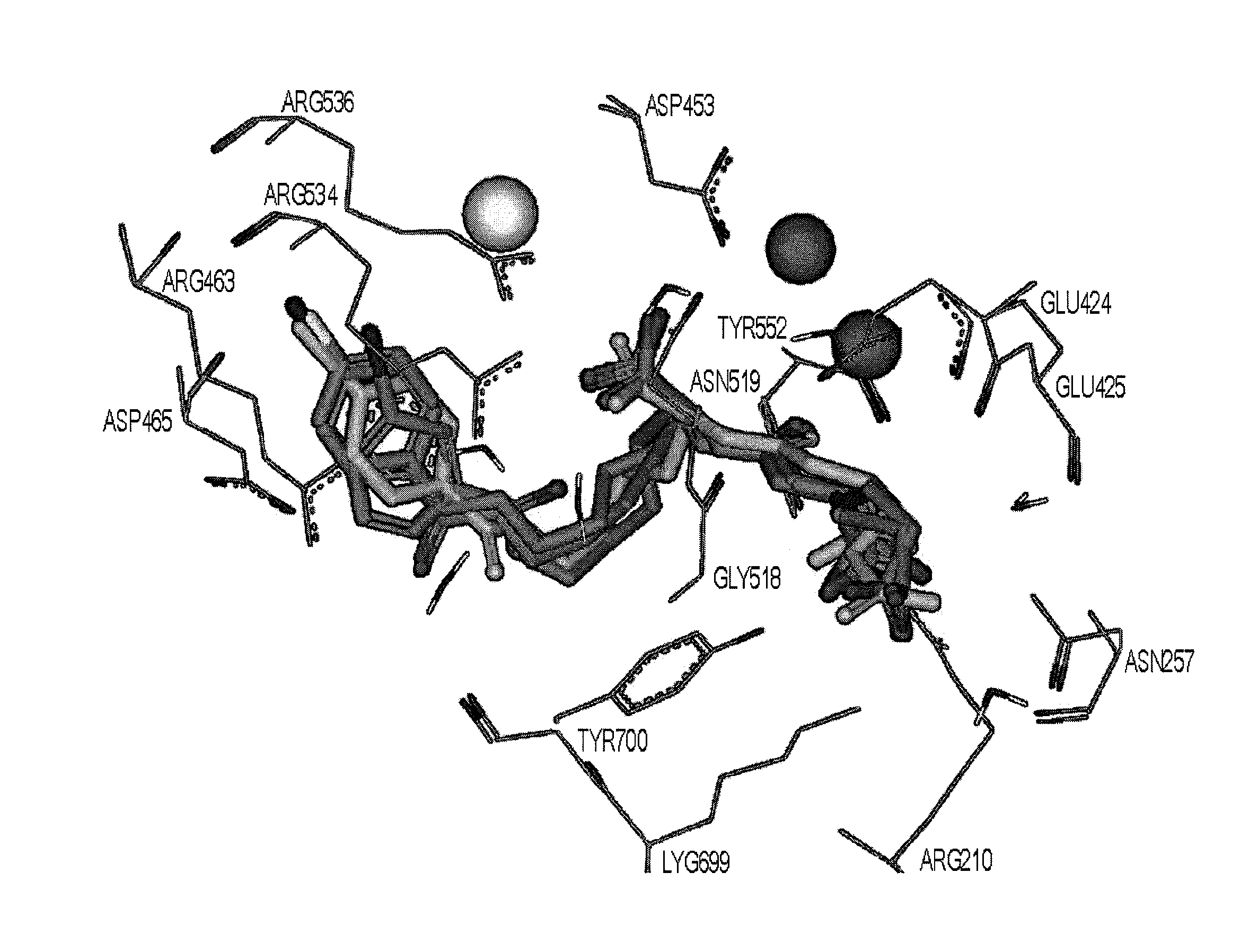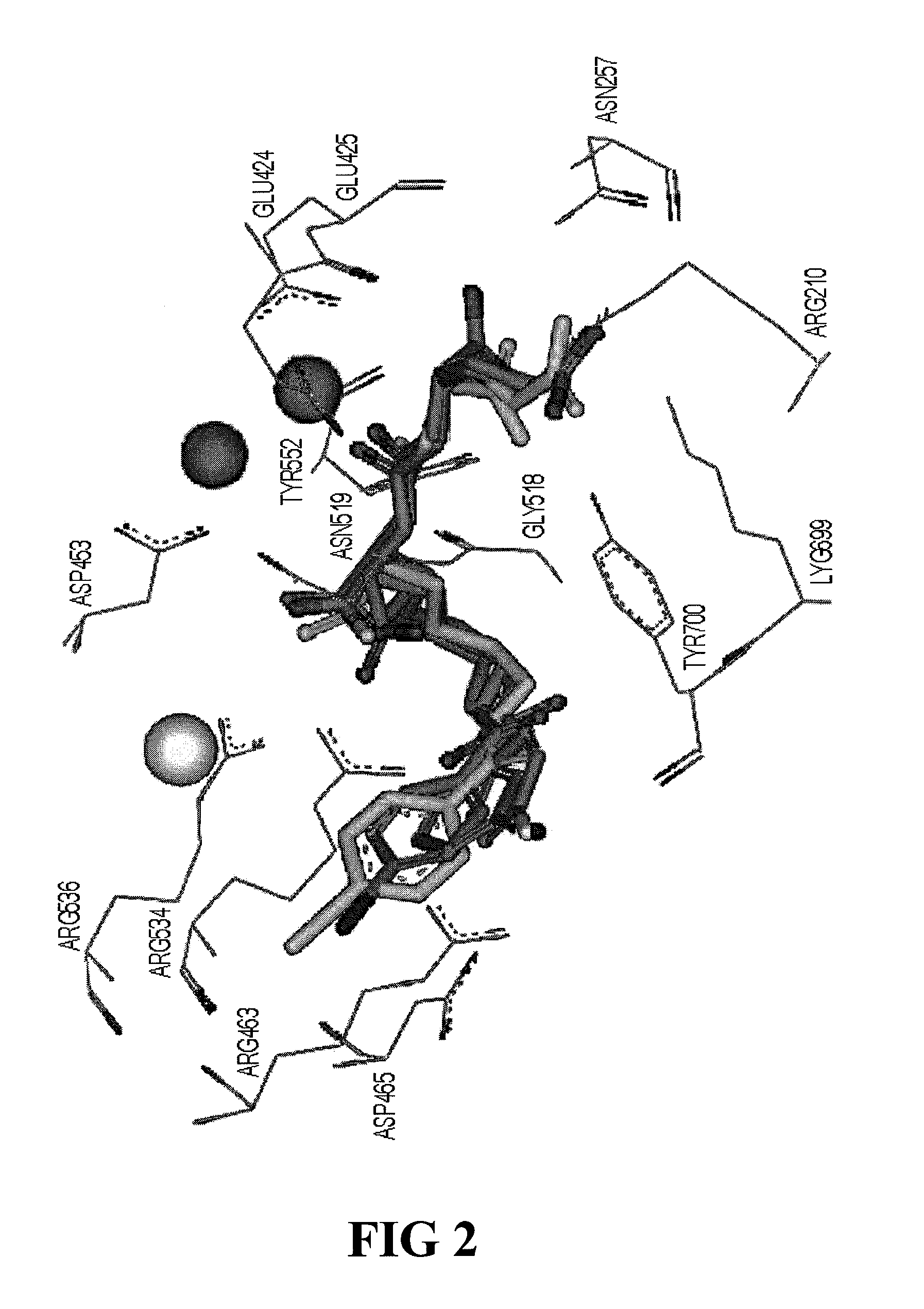Psma-binding agents and uses thereof
a prostate specific membrane antigen and binding compound technology, applied in the field of psma-binding compounds, can solve the problems of ineffective diagnostic imaging of pca, particularly difficult detection of pca using existing molecular imaging tracers, fluorodeoxyglucose (fdg-pet) and other problems, to achieve the effect of satisfying the long standing and unmet needs and better contras
- Summary
- Abstract
- Description
- Claims
- Application Information
AI Technical Summary
Benefits of technology
Problems solved by technology
Method used
Image
Examples
example 1
[0100]2-{3-[5-(4-Iodo-benzoylamino)-1-(4-methoxy-benzyloxycarbonyl)-pentyl]-ureido}-pentanedioic acid bis-(4-methoxy-benzyl)ester (2). To a solution of 1 (0.126 g, 0.148 mmol) in CH2Cl2 (4 mL) was added triethylamine (0.1 mL, 0.712 mmol), followed by N-hydroxysuccinimidyl-4-iodobenzoate (24) (0.073 g, 0.212 mmol). After stirring for 2 h at room temperature, the solvent was evaporated on a rotary evaporator. The crude material was purified on a silica column using methanol / methylene chloride (5:95) to afford 0.127 g (94%) of 2. 1H NMR (400 MHz, CDCl3) δ 7.69 (d, J=8.8 Hz, 2H), 7.49 (d, J=8.8 Hz, 2H), 7.17-7.26 (m, 6H), 6.77-6.86 (m, 7H), 5.37-5.46 (m, 2H), 4.93-5.09 (m, 6H), 4.32-4.40 (m, 2H), 3.76-3.77 (m, 9H), 3.30-3.33 (m, 2H), 2.30-2.36 (m, 2H), 2.07-2.12 (m, 1H), 1.84-1.92 (m, 1H), 1.70-1.79 (m, 1H), 1.49-1.57 (m, 3H), 1.25-1.33 (m, 2H). ESI-Mass calcd for C43H48IN3O11Na [M+Na]+ 932.2, found 932.7.
example 2
[0101]2-{3-[1-Carboxy-5-(4-iodo-benzoylamino)-pentyl]ureido}-pentanedioic acid (3). A solution of 3% anisole in TFA (15 mL) was added to 2 (0.117 g, 0.129 mmol) at 0° C. The mixture was stirred at room temperature for 30 min then concentrated on a rotary evaporator. The crude material was purified by HPLC (Econosil C18 10μ, 250×10 mm, H2O / CH3CN / TFA (70 / 30 / 0.1), 4 mL / min, 3 eluting at 11 min) to afford 0.040 g (57%) of 3. 1H NMR (400 MHz, D2O:CD3CN=1:1 (v / v)) δ 7.79 (d, J=8.0 Hz, 2H), 7.46 (d, J=8.0 Hz, 2H), 4.08-4.16 (m, 2H), 3.26 (m, 2H), 2.35 (m, 2H), 2.00-2.03 (m, 1H), 1.72-1.84 (m, 2H), 1.52-1.62 (m, 3H), 1.34-1.36 (m, 2H). ESI-Mass calcd for C19H24IN3O8Na [M+Na]+ 572.1, found 572.0. FAB-HRMS calcd for C19H25IN3O8 [M+H]+ 550.0686, found 550.0648.
example 3
[0102]2-{3-[1-(4-Methoxy-benzyloxycarbonyl)-5-(4-tributylstannanyl-benzoylamino)-pentyl]-ureido}-pentanedioic acid bis-(4-methoxy-benzyl)ester (4). To a solution of 1 (0.120 g, 0.148 mmol) in CH2Cl2 (6 mL) was added triethylamine (0.1 ml, 0.712 mmol), followed by N-hydroxysuccinimidyl-4-tributylstannylbenzoate (24) (0.075 g, 0.147 mmol). After stirring for 2 h at room temperature, the reaction mixture was condensed on a rotary evaporator. The crude material was purified on a silica column using methanol / methylene chloride (5:95) to afford 0.130 g (86%) of 4. 1H NMR (400 MHz, CDCl3) δ 7.68 (d, J=8.4 Hz, 2H), 7.49 (d, J=7.6 Hz, 2H), 7.18-7.24 (m, 6H), 6.80-6.85 (m, 6H), 6.47 (m, 1H), 5.44-5.47 (m, 2H), 4.95-5.09 (m, 6H), 4.41-4.45 (m, 2H), 3.76-3.77 (m, 9H), 3.32-3.38 (m, 2H), 2.35-2.37 (m, 2H), 2.08-2.16 (m, 1H), 1.90-1.94 (m, 1H), 1.70-1.79 (m, 1H), 1.45-1.64 (m, 9H), 1.24-1.30 (m, 8H), 1.01-1.06 (m, 6H), 0.85-0.87 (m, 9H). ESI-Mass calcd for C55H75N3O11SnNa [M+Na]+ 1096.4, found 10...
PUM
| Property | Measurement | Unit |
|---|---|---|
| Capacitance | aaaaa | aaaaa |
| Inhibition | aaaaa | aaaaa |
| Structure | aaaaa | aaaaa |
Abstract
Description
Claims
Application Information
 Login to View More
Login to View More - R&D
- Intellectual Property
- Life Sciences
- Materials
- Tech Scout
- Unparalleled Data Quality
- Higher Quality Content
- 60% Fewer Hallucinations
Browse by: Latest US Patents, China's latest patents, Technical Efficacy Thesaurus, Application Domain, Technology Topic, Popular Technical Reports.
© 2025 PatSnap. All rights reserved.Legal|Privacy policy|Modern Slavery Act Transparency Statement|Sitemap|About US| Contact US: help@patsnap.com



